2018 CHRYSLER PACIFICA HYBRID radiator
[x] Cancel search: radiatorPage 458 of 614
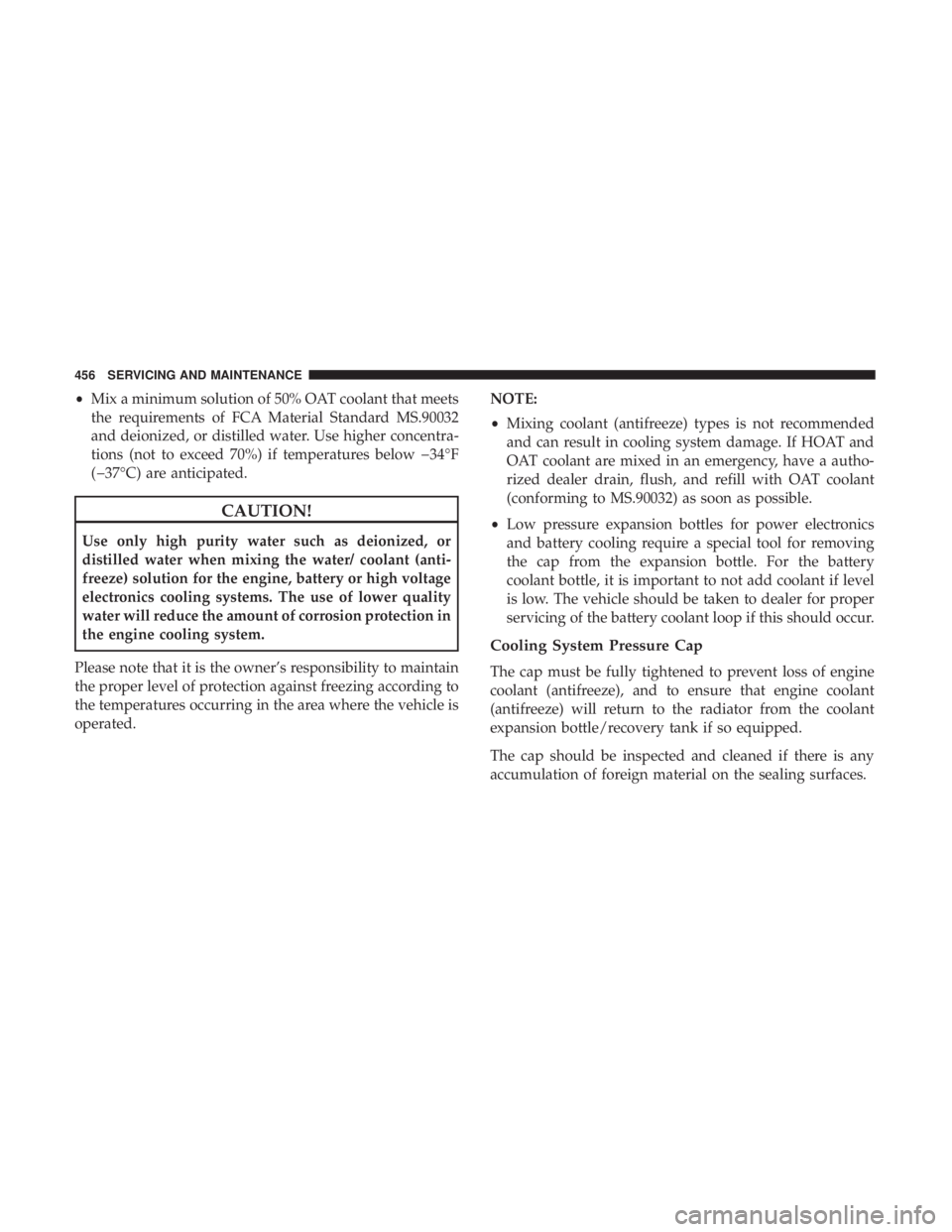
•Mix a minimum solution of 50% OAT coolant that meets
the requirements of FCA Material Standard MS.90032
and deionized, or distilled water. Use higher concentra-
tions (not to exceed 70%) if temperatures below �34°F
(�37°C) are anticipated.
CAUTION!
Use only high purity water such as deionized, or
distilled water when mixing the water/ coolant (anti-
freeze) solution for the engine, battery or high voltage
electronics cooling systems. The use of lower quality
water will reduce the amount of corrosion protection in
the engine cooling system.
Please note that it is the owner’s responsibility to maintain
the proper level of protection against freezing according to
the temperatures occurring in the area where the vehicle is
operated. NOTE:
•
Mixing coolant (antifreeze) types is not recommended
and can result in cooling system damage. If HOAT and
OAT coolant are mixed in an emergency, have a autho-
rized dealer drain, flush, and refill with OAT coolant
(conforming to MS.90032) as soon as possible.
• Low pressure expansion bottles for power electronics
and battery cooling require a special tool for removing
the cap from the expansion bottle. For the battery
coolant bottle, it is important to not add coolant if level
is low. The vehicle should be taken to dealer for proper
servicing of the battery coolant loop if this should occur.
Cooling System Pressure Cap
The cap must be fully tightened to prevent loss of engine
coolant (antifreeze), and to ensure that engine coolant
(antifreeze) will return to the radiator from the coolant
expansion bottle/recovery tank if so equipped.
The cap should be inspected and cleaned if there is any
accumulation of foreign material on the sealing surfaces.
456 SERVICING AND MAINTENANCE
Page 459 of 614
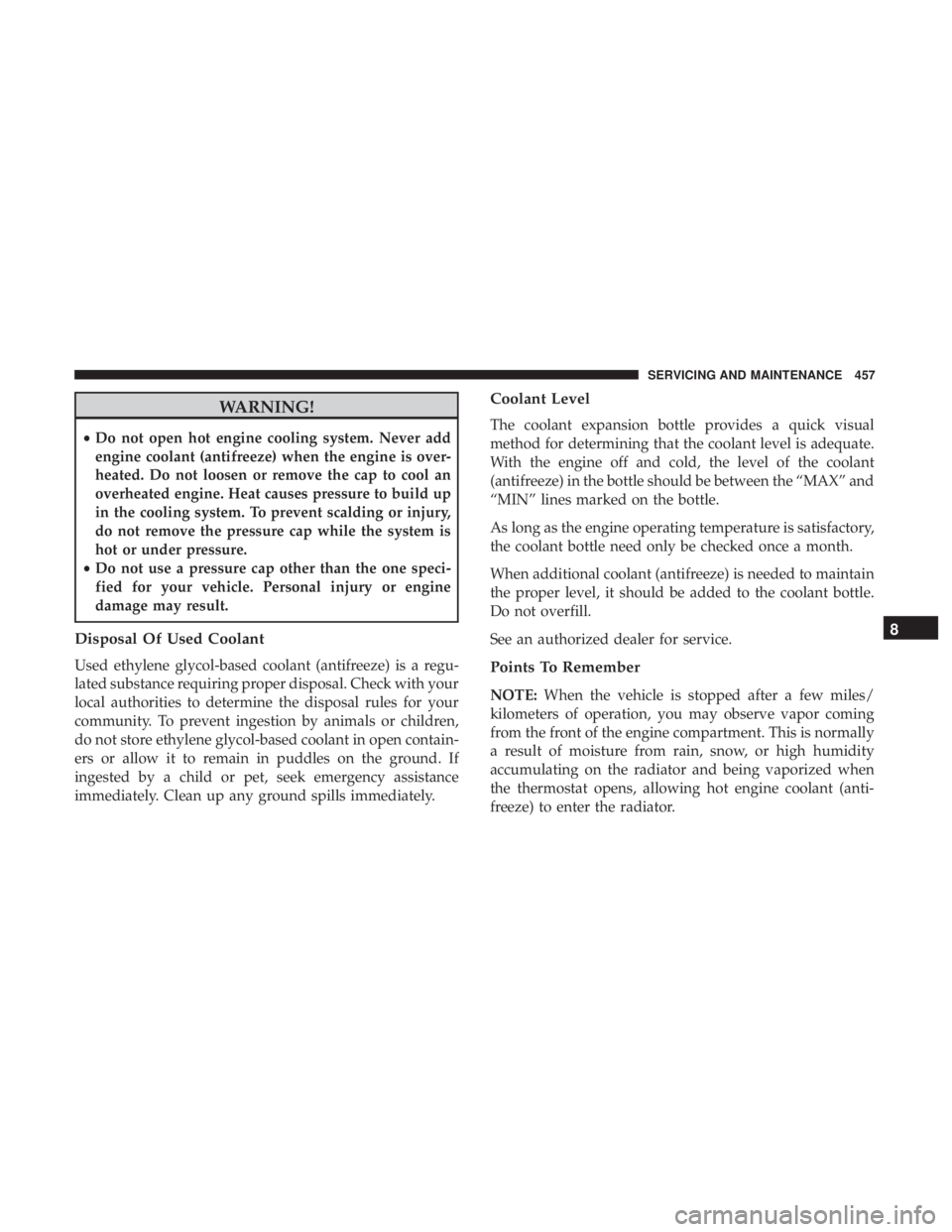
WARNING!
•Do not open hot engine cooling system. Never add
engine coolant (antifreeze) when the engine is over-
heated. Do not loosen or remove the cap to cool an
overheated engine. Heat causes pressure to build up
in the cooling system. To prevent scalding or injury,
do not remove the pressure cap while the system is
hot or under pressure.
• Do not use a pressure cap other than the one speci-
fied for your vehicle. Personal injury or engine
damage may result.
Disposal Of Used Coolant
Used ethylene glycol-based coolant (antifreeze) is a regu-
lated substance requiring proper disposal. Check with your
local authorities to determine the disposal rules for your
community. To prevent ingestion by animals or children,
do not store ethylene glycol-based coolant in open contain-
ers or allow it to remain in puddles on the ground. If
ingested by a child or pet, seek emergency assistance
immediately. Clean up any ground spills immediately.
Coolant Level
The coolant expansion bottle provides a quick visual
method for determining that the coolant level is adequate.
With the engine off and cold, the level of the coolant
(antifreeze) in the bottle should be between the “MAX” and
“MIN” lines marked on the bottle.
As long as the engine operating temperature is satisfactory,
the coolant bottle need only be checked once a month.
When additional coolant (antifreeze) is needed to maintain
the proper level, it should be added to the coolant bottle.
Do not overfill.
See an authorized dealer for service.
Points To Remember
NOTE: When the vehicle is stopped after a few miles/
kilometers of operation, you may observe vapor coming
from the front of the engine compartment. This is normally
a result of moisture from rain, snow, or high humidity
accumulating on the radiator and being vaporized when
the thermostat opens, allowing hot engine coolant (anti-
freeze) to enter the radiator.
8
SERVICING AND MAINTENANCE 457
Page 460 of 614

If an examination of your engine compartment shows no
evidence of radiator or hose leaks, the vehicle may be
safely driven. The vapor will soon dissipate.
•Do not overfill the coolant expansion bottle.
• Check the coolant freeze point in the radiator and in the
coolant expansion bottle. If engine coolant (antifreeze)
needs to be added, the contents of the coolant expansion
bottle must also be protected against freezing.
• If frequent engine coolant (antifreeze) additions are
required, the cooling system should be pressure tested
for leaks.
• Maintain coolant (antifreeze) concentration at a mini-
mum of 50% OAT coolant (conforming to MS.90032) and
deionized, or distilled water.
• Use only high purity water such as deionized, or dis-
tilled water when mixing the water/coolant (antifreeze)
solution for the engine, battery or high voltage electron-
ics cooling systems. The use of lower quality water will
reduce the amount of corrosion protection in the cooling
system.
• Make sure that the coolant expansion bottle overflow
hoses are not kinked or obstructed. •
Keep the front of the radiator clean. If your vehicle is
equipped with air conditioning, keep the front of the
condenser clean.
• Do not change the thermostat for Summer or Winter
operation. If replacement is ever necessary, install ONLY
the correct type thermostat. Other designs may result in
unsatisfactory engine coolant (antifreeze) performance,
poor gas mileage, and increased emissions.
• The coolant freeze point in the battery and power
electronics loop should be checked by a dealer as a
special tool is required to remove the cap from those
expansion bottles.
• Electric/Battery coolant system must be serviced by an
authorized dealer. If the coolant level is below what is
specified on the reservoir, contact an authorized dealer
for service. These systems require the use of high purity
water such as deionized, or distilled water when mixing
the water and coolant (antifreeze) solution. The use of
lower quality water will reduce the amount of corrosion
protection in the cooling systems.
Brake System
In order to assure brake system performance, all brake
system components should be inspected periodically. Refer
458 SERVICING AND MAINTENANCE
Page 502 of 614

ComponentFluid, Lubricant, or Genuine Part
Engine Oil Filter We recommend you use a Mopar Engine Oil Filter.
Spark Plugs We recommend you use Mopar Spark Plugs.
Fuel Selection 87 Octane, 0-15% Ethanol (Do not use E-85).
CAUTION!
•Mixing of engine coolant (antifreeze) other than
specified Organic Additive Technology (OAT) en-
gine coolant (antifreeze), may result in engine dam-
age and may decrease corrosion protection. Organic
Additive Technology (OAT) engine coolant is differ-
ent and should not be mixed with Hybrid Organic
Additive Technology (HOAT) engine coolant (anti-
freeze) or any “globally compatible” coolant (anti-
freeze). If a non-OAT engine coolant (antifreeze) is
introduced into the cooling system in an emergency,
the cooling system will need to be drained, flushed,
and refilled with fresh OAT coolant (conforming to
MS.90032), by an authorized dealer as soon as pos-
sible.
(Continued)
CAUTION! (Continued)
•Do not use water alone or alcohol-based engine
coolant (antifreeze) products. Do not use additional
rust inhibitors or antirust products, as they may not
be compatible with the radiator engine coolant and
may plug the radiator.
• This vehicle has not been designed for use with
propylene glycol-based engine coolant (antifreeze).
Use of propylene glycol-based engine coolant (anti-
freeze) is not recommended.
500 TECHNICAL SPECIFICATIONS
Page 597 of 614
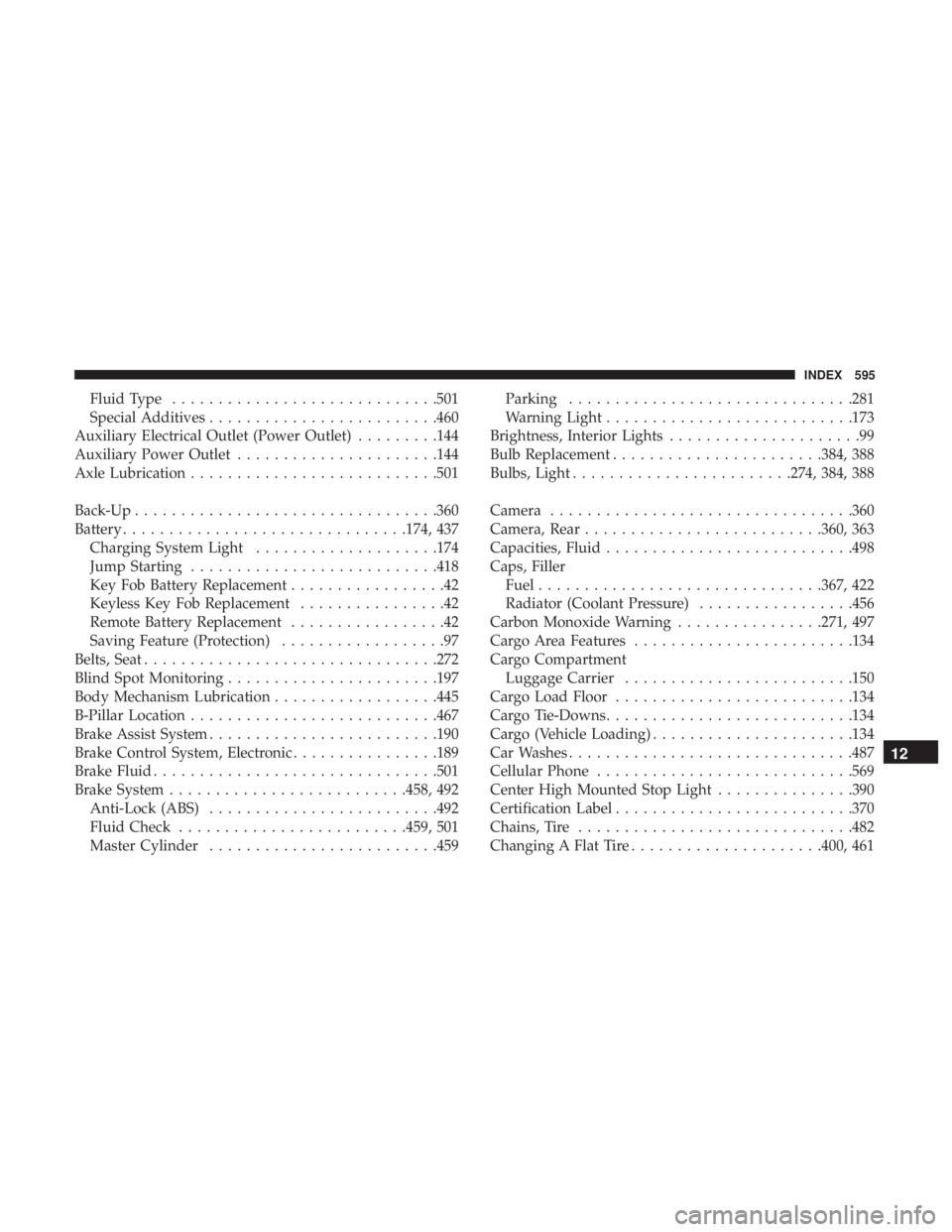
Fluid Type............................ .501
Special Additives ........................ .460
Auxiliary Electrical Outlet (Power Outlet) .........144
Auxiliary Power Outlet ..................... .144
Axle Lubrication .......................... .501
Back-Up ................................ .360
Battery .............................. .174, 437
Charging System Light ....................174
Jump Starting .......................... .418
Key Fob Battery Replacement .................42
Keyless Key Fob Replacement ................42
Remote Battery Replacement .................42
Saving Feature (Protection) ..................97
Belts, Seat ............................... .272
Blind Spot Monitoring ...................... .197
Body Mechanism Lubrication ..................445
B-Pillar Location .......................... .467
Brake Assist System ........................ .190
Brake Control System, Electronic ................189
Brake Fluid .............................. .501
Brake System ......................... .458, 492
Anti-Lock (ABS) ........................ .492
Fluid Check ........................ .459, 501
Master Cylinder ........................ .459Parking
.............................. .281
Warning Light .......................... .173
Brightness, Interior Lights .....................99
Bulb Replacement ...................... .384, 388
Bulbs, Light ....................... .274, 384, 388
Camera ................................ .360
Camera, Rear ......................... .360, 363
Capacities, Fluid .......................... .498
Caps, Filler Fuel .............................. .367, 422
Radiator (Coolant Pressure) .................456
Carbon Monoxide Warning ................271, 497
Cargo Area Features ....................... .134
Car
go Compartment
Luggage Carrier ........................ .150
Cargo Load Floor ......................... .134
Cargo Tie-Downs .......................... .134
Cargo (Vehicle Loading) ..................... .134
Car Washes .............................. .487
Cellular Phone ........................... .569
Center High Mounted Stop Light ...............390
Certification Label ......................... .370
Chains, Tire ............................. .482
Changing A Flat Tire .....................400, 461
12
INDEX 595
Page 598 of 614
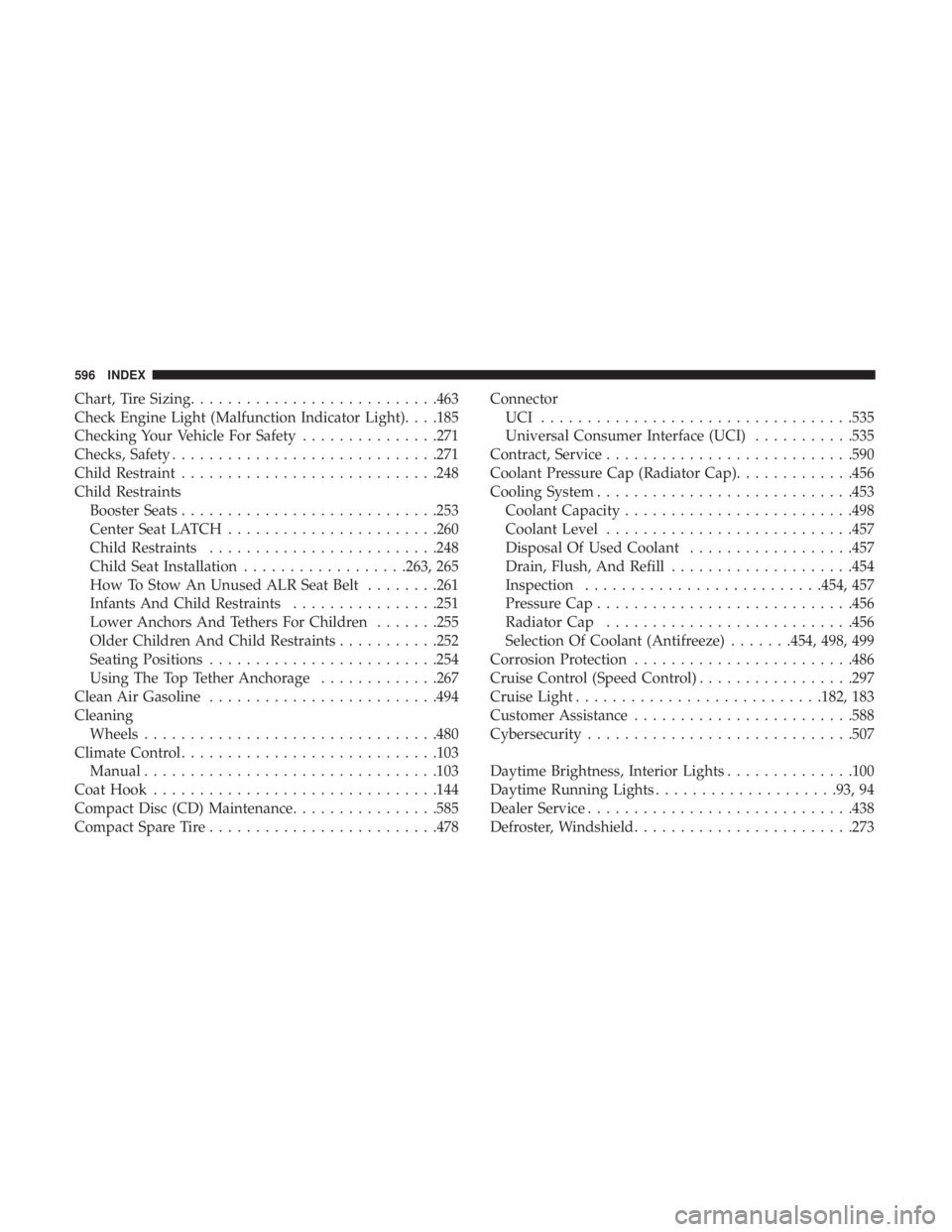
Chart, Tire Sizing.......................... .463
Check Engine Light (Malfunction Indicator Light). . . .185
Checking Your Vehicle For Safety ...............271
Checks, Safety ............................ .271
Child Restraint ........................... .248
Child Restraints Booster Seats ........................... .253
Center Seat LATCH ...................... .260
Child Restraints ........................ .248
Child Seat Installation ..................263, 265
How To Stow An Unused ALR Seat Belt ........261
Infants And Child Restraints ................251
Lower Anchors And Tethers For Children .......255
Older Children And Child Restraints ...........252
Seating Positions ........................ .254
Using The Top Tether Anchorage .............267
Clean Air Gasoline ........................ .494
Cleaning Wheels ............................... .480
Climate Control ........................... .103
Manual ............................... .103
Coat Hook .............................. .144
Compact Disc (CD) Maintenance ................585
Compact Spare Tire ........................ .478Connector
UCI ................................. .535
Universal Consumer Interface (UCI) ...........535
Contract, Service .......................... .590
Coolant Pressure Cap (Radiator Cap) .............456
Cooling System ........................... .453
Coolant Capacity ........................ .498
Coolant Level .......................... .457
Disposal Of Used Coolant ..................457
Drain, Flush, And Refill ....................454
Inspection ......................... .454, 457
Pressure Cap ........................... .456
Radiator Cap .......................... .456
Selection
Of Coolant (Antifreeze) .......454, 498, 499
Corrosion Protection ....................... .486
Cruise Control (Speed Control) .................297
Cruise Light .......................... .182, 183
Customer Assistance ....................... .588
Cybersecurity ............................ .507
Daytime Brightness, Interior Lights ..............100
Daytime Running Lights ....................93, 94
Dealer Service ............................ .438
Defroster, Windshield ....................... .273
596 INDEX
Page 604 of 614
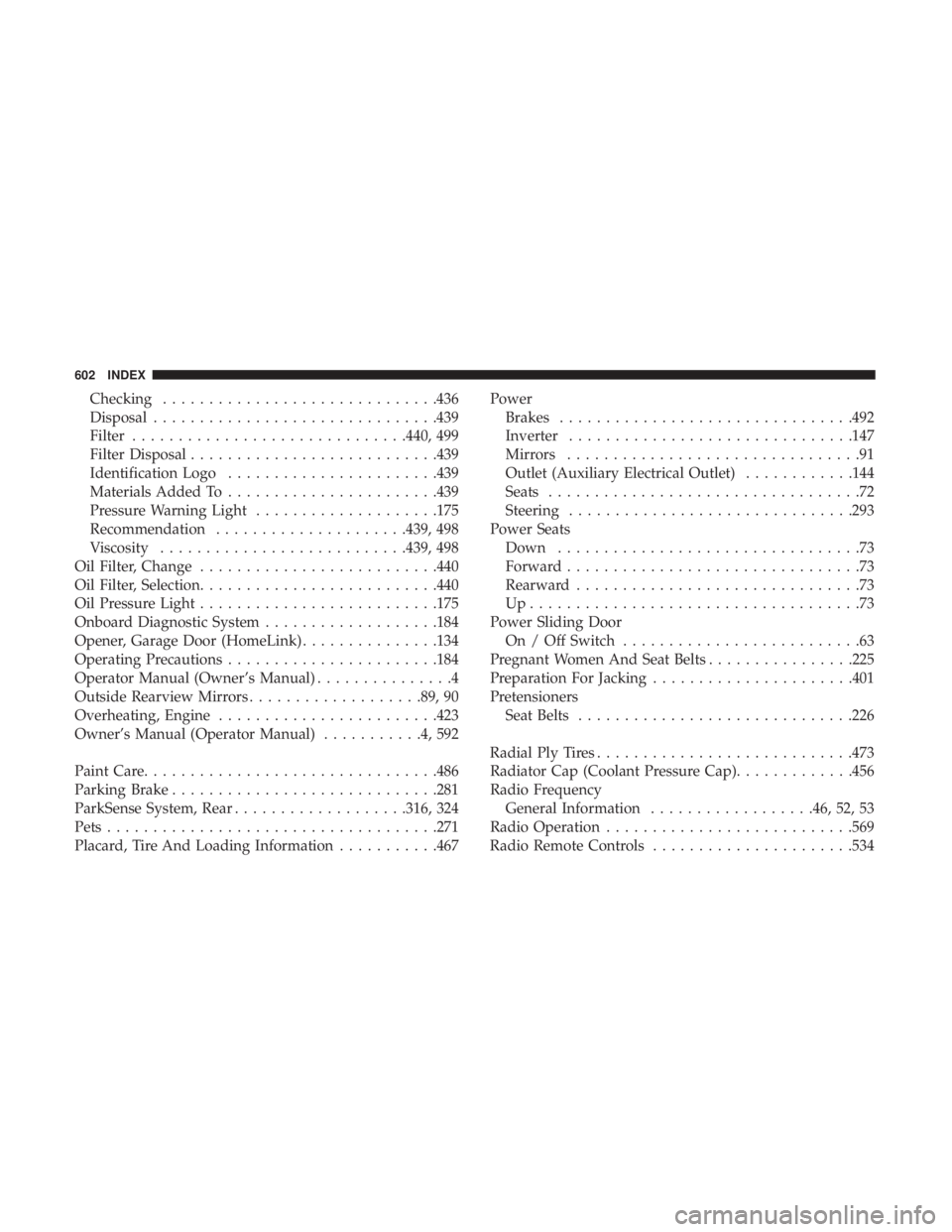
Checking............................. .436
Disposal .............................. .439
Filter ............................. .440, 499
Filter Disposal .......................... .439
Identification Logo ...................... .439
Materials Added To ...................... .439
Pressure Warning Light ....................175
Recommendation .....................439, 498
Viscosity .......................... .439, 498
Oil Filter, Change ......................... .440
Oil Filter, Selection ......................... .440
Oil Pressure Light ......................... .175
Onboard Diagnostic System ...................184
Opener, Garage Door (HomeLink) ...............134
Operating Precautions ...................... .184
Operator Manual (Owner’s Manual) ...............4
Outside Rearview Mirrors ...................89, 90
Overheating, Engine ....................... .423
Owner’s Manual (Operator Manual) ...........4,592
Paint Care ............................... .486
Parking Brake ............................ .281
ParkSense System, Rear ...................316, 324
Pets ................................... .271
Placard, Tire And Loading Information ...........467Power
Brakes ............................... .492
Inverter .............................. .147
Mirrors ................................91
Outlet (Auxiliary Electrical Outlet) ............144
Seats ..................................72
Steering .............................. .293
Power Seats Down .................................73
Forward ................................73
Rearward ...............................73
Up....................................73
Power Sliding Door On / Off Switch ..........................63
Pregnant Women And Seat Belts ................225
Preparation For Jacking ..................... .401
Pr
etensionersSeat Belts ............................. .226
Radial Ply Tires ........................... .473
Radiator Cap (Coolant Pressure Cap) .............456
Radio Frequency General Information ..................46, 52, 53
Radio Operation .......................... .569
Radio Remote Controls ..................... .534
602 INDEX